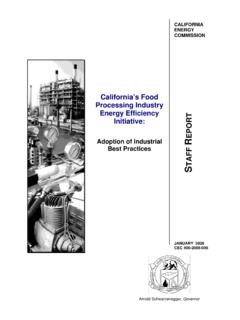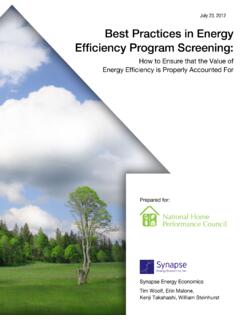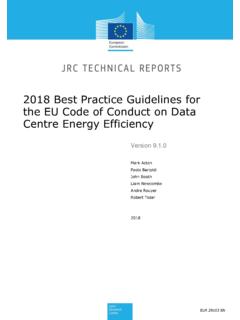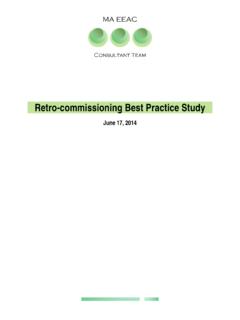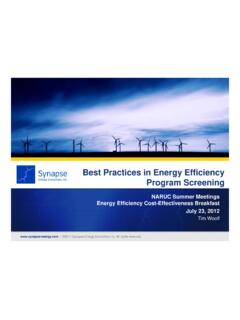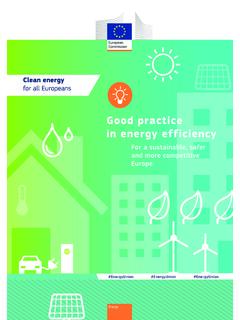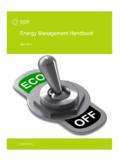Transcription of Best Practices in Municipal Energy Management …
1 best Practices in Municipal Energy Management and efficiency South Bend Green Ribbon Commission Energy Group Lead Researchers Elizabeth Morse, Dima Allan, Gregory Frushour Fall 2015 Research for this paper was conducted by graduate students in Indiana University South Bend Graduate Certificate in Strategic Sustainability Leadership in collaboration with Professor Mike Keen, Director of the IU South Bend Center for a Sustainable Future and the IU South Bend Sustainability Studies Program. Page 1 Executive Summary Across the nation, American municipalities are taking numerous measures to improve the ecological friendliness, economic soundness, and health and wellness of their communities and citizens.
2 They have identified and executed dozens of initiatives to reduce environmental impact and save tax payer dollars. In this paper, we identify 10 best Practices in Municipal Energy efficiency and Management that could be used here in South Bend to realize similar savings. We also provide links and references, and examples for each. The Municipal Energy efficiency projects implemented by the 23 cities examined for this report already have resulted in an ongoing net savings of $3,180,375 per year. The data for this paper was collected from comprehensive plans and annual reports of municipalities in Indiana, the Midwest, and beyond, EPA reports, and reports from the Department of Energy .
3 In each section the data is presented geographically, beginning with Indiana, followed by contiguous states and beyond. best Practices in Municipal Energy efficiency and Management from currently in place with documented results and savings include: 1. Energy Audits and Baseline Analyses 2. Clearly Established and Ambitious Metrics for Energy Savings 3. Summer and Winter Temperature Set Points across Municipal Facilities 4. Energy -Efficient Procurement Policies 5. Dedicated Energy Savings Reinvestment Plans 6. Municipal Building Upgrades and Retrofits 7. Municipal Fleet Fuel efficiency 8.
4 Upgrade and Retrofit of Waste Water Treatment Facilities 9. Municipal Waste to Energy Programs 10. Renewable Energy Projects Page 2 best Practice in Municipal Energy Management Municipal governments are typically elected on a platform of improving the quality of life of their citizens within the limitations of budget constraints. In this paper we have identified initiatives have that other mid-sized cities have undertaken to save tax payer dollars and reduce their environmental impact. The 10 best Practices in Municipal Energy efficiency outlined in this paper have demonstrated a favorable return on investment and could be implemented in South Bend with similar results.
5 1. Energy Audits and Baseline Analyses For a municipality to implement a comprehensive Energy efficiency and Management plan, the first step is to conduct an Energy audit to establish usage and cost baselines. The Local Government Operation Protocol and the Clean Air and Climate Protection Software is commonly used to inventory Energy use and costs. Each year s inventory enables the city to make comparisons, measure success, and make new recommendations. This analysis creates a valuable feedback loop for fine-tuning the estimated impact of existing policies and programs on Energy reductions and savings.
6 For example, Bloomington IN, purchased an Energy dashboard that enables it to monitor its Energy usage on an hourly basis and make use and cost comparisons by day, month, or years. Using information from the dashboard, Bloomington was able to reduce electrical usage early in the morning and on This helped them to reduce their Energy usage by 13% in 2013,2saving more than $200,000 in Energy expenses per year going forward. In 2006 Boulder CO, started documenting Energy usage in city buildings. By using this data to implement targeted efficiency upgrades they saved $529, In 2010 Holland MI established a baseline based on an inventory of all city buildings.
7 Demonstrated Energy savings afterwards averaged 34% for the 25 retrofitted buildings with average annual savings of $28,000. 2. Clearly Established and Ambitious Metrics for Energy Savings Like commercial businesses, cities understand the need to reduce their Energy costs through effective Energy Management Practices that involve establishing baseline Energy performance, setting Energy -savings goals, and regularly evaluating progress. Energy use should be tracked at the granular level and normalized overtime to account for Energy price fluctuation. Energy efficiency upgrades need to be monitored to ensure the expected savings are Many cities have begun to use building dashboards to provide immediate feedback on building Energy use.
8 Fayetteville, AK committed to becoming a sustainable city in 2007. Their Energy efficiency investments since then are saving more than $400,000 a year. Page 3 In 2008, the mayor of Louisville KY launched GO Green Louisville in order to decrease Energy use in the city 25% (based on a 2010 baseline) by 2025. Energy efficiency upgrades were implemented in 24 city-owned buildings. In 2013, a report verified that the city had achieved a 7% reduction in electricity use, saving more than $750,000 in Energy bills compared to In 2000 Berkeley CA adopted a sustainable Energy plan.
9 Commercial electricity consumption decreased 7% between 2000 and 2013. As of 2013, cumulative annual savings on Energy bills across all Berkeley businesses served by Smart Lights exceeded $ million. Upgrades to Municipal building systems, lighting and HVAC controls resulted in approximately $380,000 savings per Lafayette CO adopted three approaches for Energy savings in 2013. The Building Permit education program generates in $100,000 annual savings and a year return on investment (ROI). The Energy efficiency Drive and Contractor Training program produces $280,000 in annual savings with a year ROI.
10 The Green Business Award Program has led to $135,000 annual savings and with a year Additional cities that have achieved similar Energy and cost savings through their comprehensive Energy plans and metrics include Boulder City CO, 8 Burlington VT, and Eugene OR. 3. Summer and Winter Temperature Set Points across Municipal Facilities The recommended temperatures for Municipal buildings, as established by American Society of Heating, Refrigerating, and Air Conditioning Engineers (ASHRAE) Standard 55-2013 Thermal Environmental Conditions for Human Occupancy are 75-78 F in the summer and 68-72 F in the For summer cooling the California Energy Commission estimates savings of 1-3% for each degree the thermostat is set above 72 F in the Implementing temperature set points is a cost-free way to save Energy .
